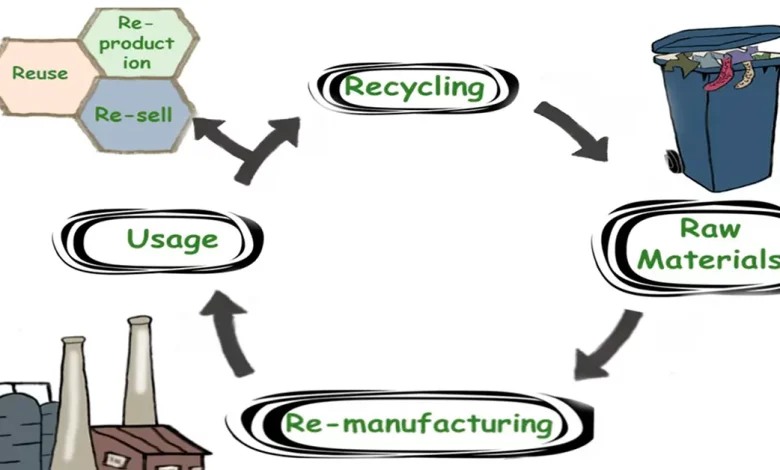Why Fashion Industry’s ‘Recycling’ Methods are not Saving the Planet?
GS Paper 1 - Environment and Climate Change

Context – Starting from the Fast-Fashion giants to other Luxury brands, many have embraced recycled fabrics and eco-friendly messaging as part of their marketing strategies. However, a closer look reveals that these recycling methods often fall short of delivering meaningful environmental benefits.
The fashion industry, renowned for its innovation and dynamism, has come under scrutiny for its environmental impact. Amidst growing concerns about sustainability, the concept of recycling within the fashion sector has gained traction. Recycling is often portrayed as a solution to mitigate the industry’s recycling methods that fall short of genuinely saving the planet.
Challenges with Fashion Recycling
While recycling holds promise as a sustainable practice, its implementation within the fashion industry faces significant challenges. The fashion industry’s fast-paced nature perpetuates a culture of disposability, where garments are quickly discarded in favor of new trends. This rapid turnover exacerbates the challenges of textile recycling, as the sheer volume of clothing produced overwhelms recycling facilities:
Greenhouse Gas Emissions:
- Polyester, a ubiquitous fabric, contributes substantially to emissions, with 28.2 million tonnes used in 2016 alone, emitting nearly triple the CO2 compared to cotton.
- Nylon production generates nitrous oxide, a potent greenhouse gas, exacerbating climate change.
Water Intensity:
- Cotton cultivation, vital for clothing production, consumes vast amounts of water, with estimates suggesting up to 20,000 liters required for a pair of jeans and a t-shirt.
- Predictions indicate potential water crises by 2030 due to escalating water consumption in clothing production.
Water Pollution:
- Chemical dyeing, essential for vibrant textiles, ranks as the second-largest polluter of clean water globally, introducing harmful substances into waterways.
- Cotton cultivation’s heavy reliance on chemicals poses health risks and environmental degradation.
Plastics and Microfibers:
- Polyester clothing sheds microfibers during washing, contaminating oceans and endangering marine life, with significant quantities entering waterways annually.
- Non-biodegradable microfibers pose risks to human health and ecosystems, persisting in the environment indefinitely.
Landfill Waste:
- The fashion industry contributes substantially to landfill waste, with discarded clothing doubling over the past two decades due to fast fashion trends.
- Limited textile recycling exacerbates the landfill problem, with less than 1% of clothing material being reused.
Inability to Recycle:
- Complex fabric blends and non-biodegradable materials like polyester and nylon present challenges to recycling technologies, hindering effective reuse.
- China’s ban on recycled textile imports exacerbates recycling issues, limiting disposal options.
Economic and Ethical Considerations:
- Economic incentives often prioritize short-term profits over sustainability, perpetuating greenwashing tactics and undermining genuine recycling efforts.
- Unethical labor practices compound sustainability challenges, highlighting systemic issues in the fashion industry’s supply chain.
Methods for Recycling
- Mechanical recycling: It breaks down textiles into fibers without altering their chemical composition, suitable for natural fibers like cotton.
- Chemical recycling: It breaks down textiles into basic chemical components, ideal for synthetic fibers like polyester.
- Steps involved: Both methods involve sorting, shredding, cleaning, processing, and quality control to produce new fabrics or products, reducing waste in the fashion industry.
Promising Alternatives:
- While the fashion industry’s recycling efforts face formidable obstacles, several promising alternatives offer a more sustainable path forward.
- One such approach is the adoption of circular economy principles, which emphasize resource efficiency, product longevity, and closed-loop systems.
- By designing clothing for durability and recyclability, fashion brands can reduce waste and minimize their environmental footprint.
- Additionally, innovations in textile recycling technology hold promise for overcoming the technical challenges associated with recycling complex fiber blends.
- Addressing the environmental impact of the fashion industry requires collaboration and innovation across the entire value chain.
- Governments, industry stakeholders, and consumers must work together to develop holistic solutions that prioritize environmental sustainability without compromising economic viability.
Moving Towards True Sustainability
- Research and Development: Invest in innovative recycling technologies capable of processing complex fabric blends.
- Transparency and Standards: Implement transparent supply chains and rigorous recycling standards to ensure accountability.
- Consumer Education: Educate consumers about the true environmental and ethical impact of their clothing choices.
- Regulation and Accountability: Enforce regulations and industry standards to hold fashion brands accountable for sustainability commitments.
- Circular Economy Promotion: Embrace circular economy principles, such as extended producer responsibility and product lifecycle management, to minimize waste and resource consumption.
Conclusion
The fashion industry’s recycling methods, while well-intentioned, are not sufficient to save the planet from environmental degradation. Addressing the systemic challenges of overconsumption, disposability, and greenwashing requires a concerted effort from all stakeholders. Achieving true sustainability demands systemic changes, including technological innovation, transparent practices, consumer awareness, regulatory enforcement, and circular economy promotion.
SOURCE: The Hindu





.png)



